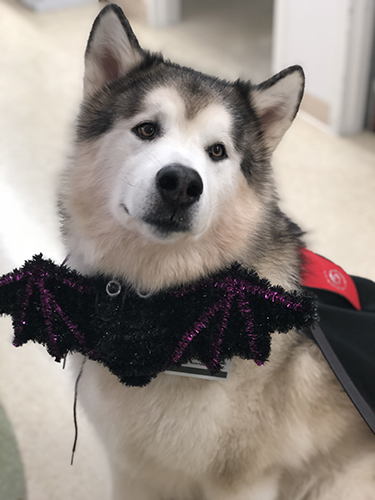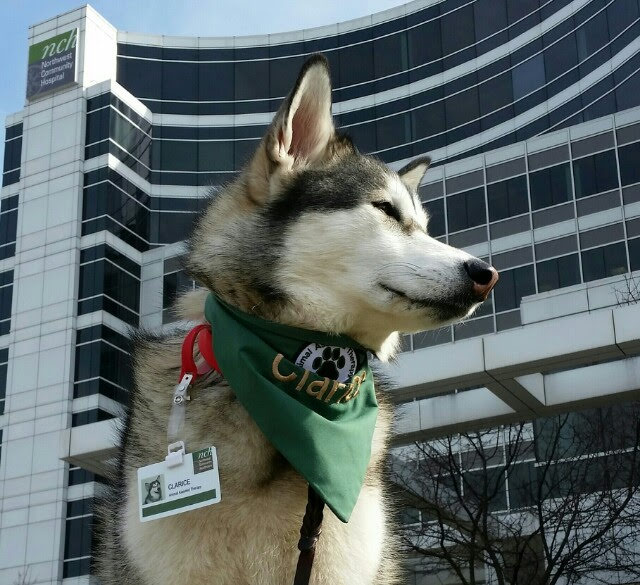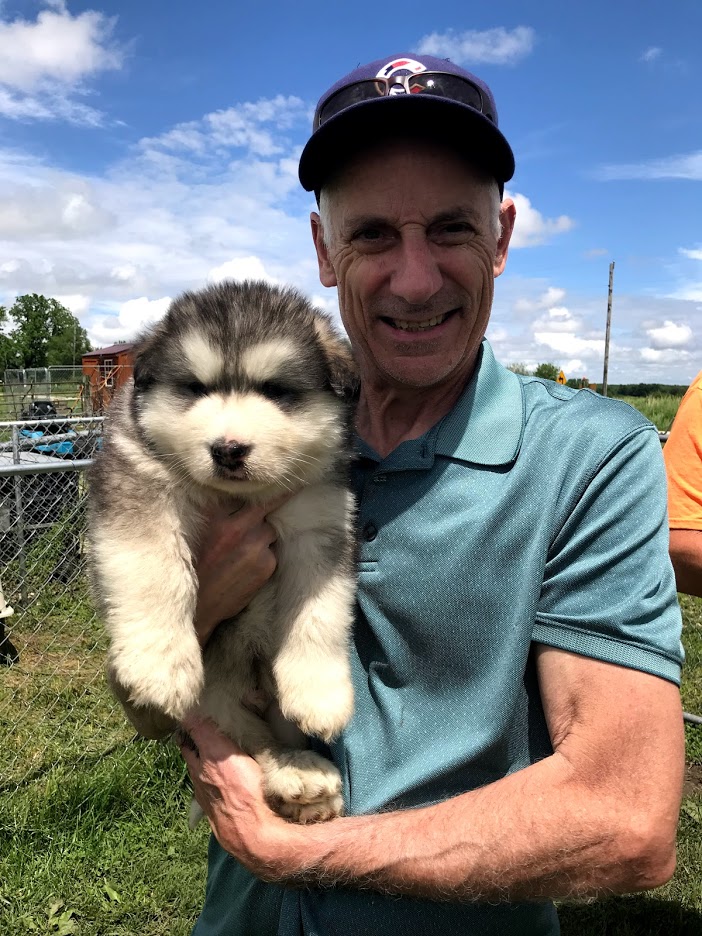Meet the past, present and future pups of NCH
September 17, 2019
How animal-assisted therapy dogs lower stress for patients and staff

When Fred Bartling retired several years ago, he envisioned himself in the role of hospital volunteer, transporting patients in wheelchairs. But for the past six years, he’s been transporting Alaskan Malamutes from his home to Northwest Community Healthcare (NCH) to visit patients and staff. Fred, a 62-year-old Arlington Heights resident, is a dedicated volunteer with NCH’s Animal-Assisted Therapy (AAT) Program.
Dog #1: Yukon
Fred was at a dog park when he met someone who thought his dog Yukon would make a great therapy dog. The person explained the AAT program at NCH to him, and Fred instantly decided that his 120-pound beauty should audition. Yukon was already obedience trained, so he easily passed an evaluation process at the hospital and then completed hospital training to become an official AAT dog. He spent years visiting with patients, but sadly he passed away from bone cancer in April 2019.
“When Yukon was sick, we had people coming to our house from the hospital,” Fred says. “Nurses were coming over. They wanted to see him one last time. It was a really cool tribute to him.”

Dog #2: Clarice
Fred’s second dog, Clarice – Fred names his dogs after characters from the movie, Rudolph the Red-Nosed Reindeer – also went through AAT evaluation and training. Clarice and Fred have visited practically every area of the hospital, including Behavioral Health, Mother/Baby, Pediatrics, Critical Care, Cancer Services and many more units to bring joy and love to patients and staff.
“When the program first started, they found out from a patient experience questionnaire that patients who’ve received a visit from these dogs had lower blood pressure, took less medication and got up and walked earlier,” explains Kathy King, who has been coordinating the program for several years. “We get comments all the time about how just a few minutes with the dogs puts people in the happy zone.”
The AAT program currently has 74 dogs (with handlers/owners) working seven days a week, 365 days a year. The newest addition, Team 15, was selected in early August and will go through hospital training in October. That involves learning – through a mock hospital room setting – how to enter a patient room, survey it and gently offer therapy by allowing patients to pet and talk to the dogs.
“There’s a lot to the training,” says Kathy. “The mock room has a bed, a chair, a tray table and an IV pole that beeps. It has everything a patient room has. The handler practices knocking on the door, going up to the mock patient, and there’s even food on the tray so the dog has to learn how not to sample that. It makes it so much easier for them once they get up on the actual floors of the hospital.”
Dog #3: Sam?

Fred is excited to be training his third dog, Sam, an Alaskan Malamute pup who’s being “groomed” for a potential future role of therapy dog. Sam is named after Snowman Sam in Rudolph, but Fred admits that Sam also stands for “Special Alaskan Malamute.”
After learning of Yukon’s passing and Fred’s desire to purchase another therapy dog to volunteer at NCH, Miller’s Malamutes, a professional breeder in Plymouth, Ill., generously offered to donate a puppy to continue the legacy of Fred’s first dog.
“The breeder said, ‘We want to give you one of our dogs for this program,’” Fred says. “They flat out offered us a dog – any one that we wanted – and that’s a big gift. An Alaskan Malamute can cost around $2,500.”
Kathy has already met Sam, who has been learning the ropes at an assisted-living facility in Arlington Heights as well as gaining experience by working one-on-one with a friend who is in a wheelchair.
“I think Sam is going to be bigger than Yukon,” Kathy says. “I saw him when he was just 12 weeks. He was big then.”
Sam will audition when he’s old enough in late summer 2020.
Circle of life
Fred volunteers four hours per week, checking in at a central station with other dogs and handlers to get his assignments for the day. Patients have to request a dog visit, so he doesn’t just go door to door. He might start his day out in Mother/Baby where new life is beginning, and he might end on the hospice floor where families are saying goodbye to loved ones.
“You can’t let the sadness get to you,” Fred says. “It’s the circle of life, and I find that it’s very nice to visit with those patients.”
Supporting staff
Willis Parsons, M.D., Medical Director of the NCH Gastroenterology Center and his team are very busy performing back-to-back colonoscopies and other procedures throughout a given day, so it’s stress-reducing to visit with the therapy dogs.
“At times we find ourselves in stressful situations taking care of very sick patients,” explains GI Technician Fathia Morales. “After a rough day, having one of the therapy dogs come up to our unit makes our day better. Dogs have an amazing way of making you feel relaxed and bringing a smile to your face.”
Dogs in the AAT Program visit on average 1,000 patients per month.
Learn more about the program or get an application to join the AAT team. You can also make a charitable donation to the program by visiting the NCH Foundation and designating Animal-Assisted Therapy.